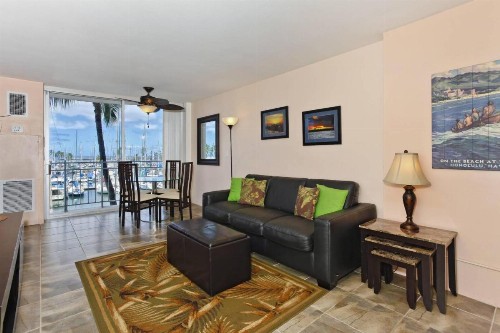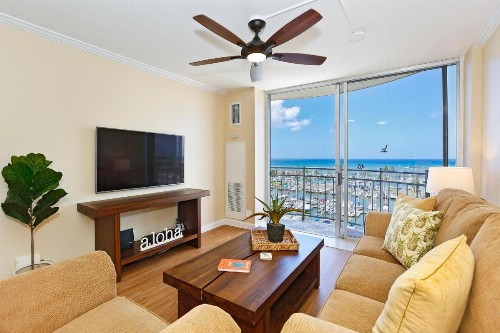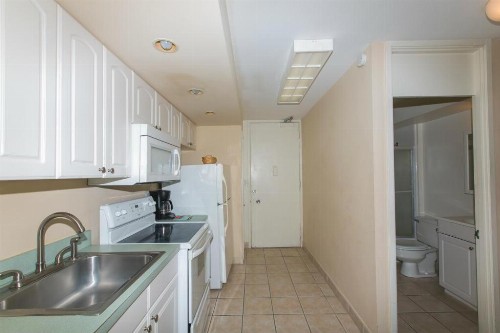Best Hotels Near Aliʻiolani Hale
1088 Bishop Street (0.4 km from Aliʻiolani Hale)
This business friendly hotel is 5 minutes’ walk away from attractions such as the Hawaii State Capitol Building and the Hawaii State Art Museum.
(0.5 km from Aliʻiolani Hale)
With a spa bath Downtown Honolulu Suite-Near Ala Moana Beach! is located in Honolulu's heart. This apartment is located 1 mile from Sand Island Beach and 1969 feet from Iolani Palace. It features free WiFi.
(2.0 km from Aliʻiolani Hale)
With a patio overlooking the garden, a garden, and a terrace Remodeled Honolulu Apartment with Courtyard Downtown! is located in Honolulu, 1.2 mi from National Memorial Cemetery of the Pacific.
1525 Rycroft Street (2.4 km from Aliʻiolani Hale)
On-site amenities include an outdoor swimming pool and sun terrace. The Pagoda Hotel is conveniently located between downtown Honolulu and gorgeous beaches. This hotel features big guest rooms and a restaurant.
410 Atkinson Drive (2.7 km from Aliʻiolani Hale)
With a newly renovated lobby Starbucks Lounge Porte Cochère and a completely renovated pool deck, the new and better Ala Moana Hotel by Mantra is ready to greet you in true Hawaiian style.
410 Atkinson Drive (2.7 km from Aliʻiolani Hale)
Set in a prime location of Oahu Hawaii LSI Resorts at Ala Moana puts everything the city has to offer just outside your doorstep. The property offers guests a range of services and amenities designed to provide comfort and convenience.
(2.7 km from Aliʻiolani Hale)
Offering sea views Ala Moana Condo by Orgoto is set in the Downtown Honolulu district of Honolulu 0.6 mi from Magic Island Lagoon Beach and 1312 feet from Hawaii Convention Center. Free WiFi is featured and private parking is available on site.
(2.7 km from Aliʻiolani Hale)
Set in the center of Honolulu 0.6 mi from Magic Island Lagoon Beach and 1312 feet from Hawaii Convention Center Ala Moana Beautiful Ocean View Studio 2342 offers a fitness center and air conditioning.
Top 10 Trending Hotels Near Aliʻiolani Hale See all
Budget Hotels Near Aliʻiolani Hale See all
Hotels With Great Access To Aliʻiolani Hale! See all
Aliʻiolani Hale, Honolulu, HI
Aliʻiolani Hale, located in Honolulu, Hawaii, is an iconic building that has embodied the spirit of justice and sovereignty of the Hawaiian people since its completion in 1874. The building was designed by architect Thomas Rowe and stands as an example of the 19th-century High Victorian architecture movement. The majestic red-brick building features a powerful, solid facade with a central dome and impressive spire at its peak. The four-story structure is surrounded by two wings and is home to various government offices, including the Supreme Court of Hawaii.
The site of Aliʻiolani Hale holds tremendous historical significance for Hawaiians as this was where King Kamehameha V proclaimed the kingdom’s first Constitution in 1864. In addition to its importance to Hawaiian history, the building also served as a refuge for Hawaiians during World War II when martial law was declared in 1941. With its foundation rooted in evoking justice and upholding sovereignty for Hawaiians, Aliʻiolani Hale remains an enduring symbol of resilience for native people throughout Hawaii today.
The architectural details of Aliʻiolani Hale are remarkable feats in their own right. Its central tower is topped with four gold leaf statues: King Kamehameha I representing law; Keoua Kuahuula representing politics; Goddess Kaahumanu representing Christian values; and Goddess Kapo representing ancient Hawaiian customs. Moreover, each corner features a figure cast from bronze depicting core elements of Hawaiian culture: surfing (on Maui), hula (on O‘ahu), holua sledding (on Hawai‘i) and canoe paddling (on Kaua‘i). These symbolic figures blend together to form what many consider a unified image of Hawaiian identity that still resonates with Hawaiians today.
Inside Aliʻiolani Hale are several courtrooms holding much cultural significance within them thanks to their elaborate designs. Ornamental motifs decorate the walls including dolphins, banyan leaves, taro plants, and feathered capes which were all once associated with royalty or nobility in Hawaii. There are also intricately carved wooden doors depicting scenes from ancient Hawaiian stories that evoke nostalgia for generations long since past. Each courtroom follows similar design themes reflecting their kapu status under aliʻi rule—items such as kapa cloth hung on windowsills or pali screens used to divide space—all aimed at ensuring special reverence be given when entering these spaces reserved only for high chiefs and nobles during pre-western contact times.
Today Aliʻiolani Hale continues to be celebrated throughout Honolulu both as a symbol of justice and sovereignty but also as one of the finest examples of High Victorian architecture remaining in America today. It is a monument that honors those who have gone before us while inspiring generations yet to come—not just through its physical grandeur but through its timeless relevance to Hawaiians across time immemorial up until today's modern age









































